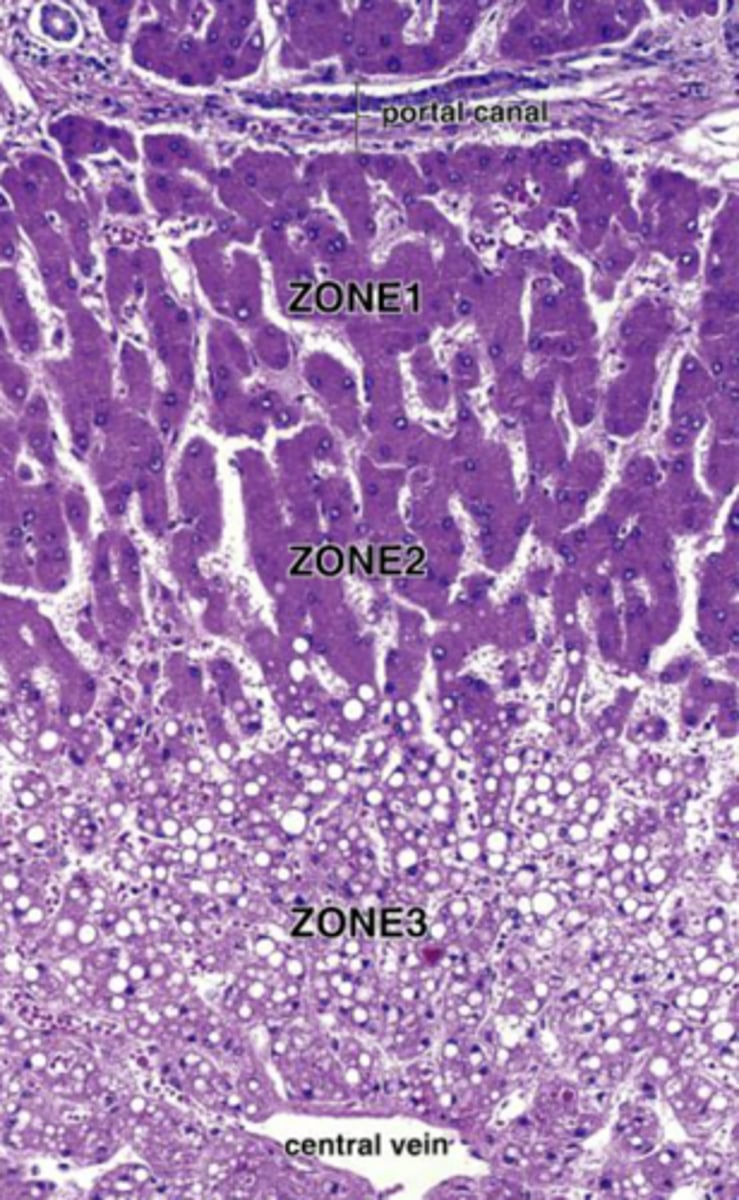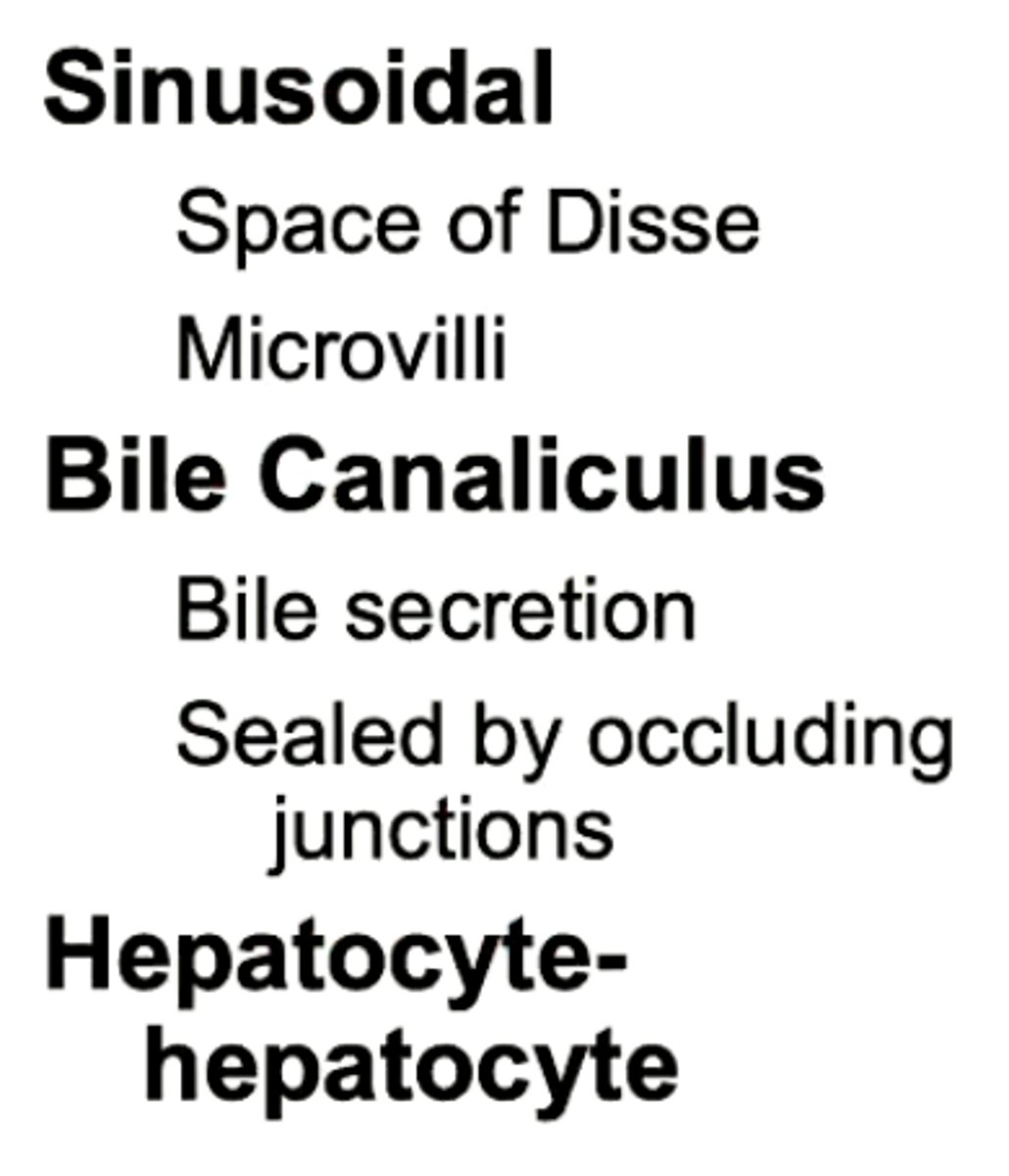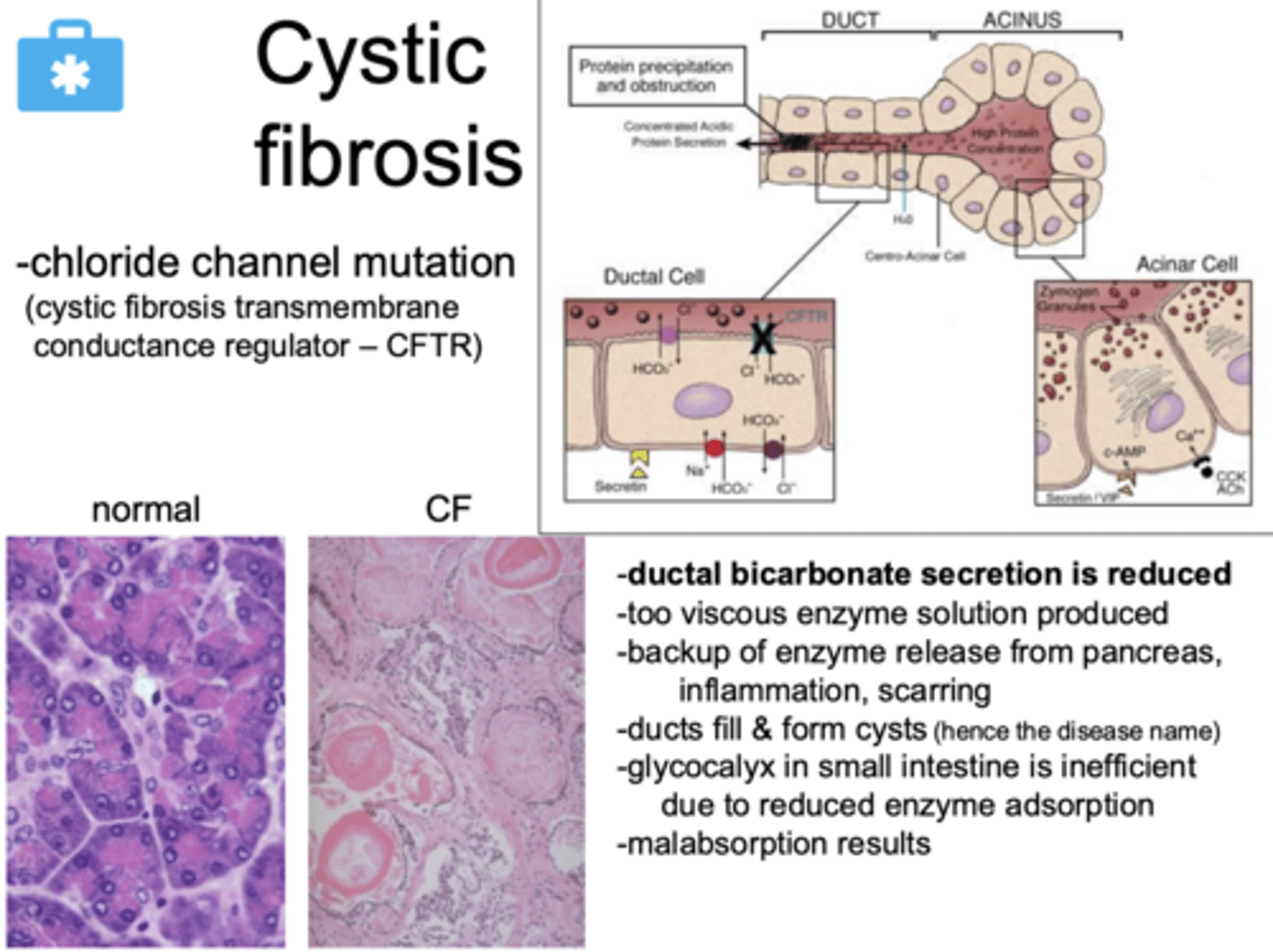GI - Histology II - Intestines, Liver, Gall Bladder & Pancreas
1/66
There's no tags or description
Looks like no tags are added yet.
Name | Mastery | Learn | Test | Matching | Spaced |
|---|
No study sessions yet.
67 Terms
what is the unique characteristic of the small intestine?
the presence of villi
T or F: there is the same amount of goblet cells in the small intestine from beginning to end?
FALSE
- there are more goblet cells as you move distally
What are the submucosal glands of the duodenum?
Brunner's glands
- in the proximal portion of the duodenum ONLY
what are the mucosal glands of the small intestine?
intestinal crypts
What do Brunner's glands secrete?
alkaline mucus
what are specialization for absorption in the small intestine?
- plicae circulares
- villi
- microvilli
- glycocalyx
what are plicae circulares? where are they found?
they are infoldings of the submucosa and are rich in the jejunum
what structure is found in the lamina propria in the villi of the small intestine?
central lacteal aka lymphatic capillary (absorbs dietary fats), and smooth muscle (continuous w muscularis mucosae)
how are fats and lipids absorbed?
through central lacteal
the glycocalyx is found on the top of what structure?
microvilli
the gylcocalyx serves what function in microvilli?
they anchor enzymes (trypsin, chymotrypsin, elastase, nucleases) for local activation
crypts are found in what layer?
mucosal layer
what is the major function of enterocytes?
control absorption
what is the role of the junctional complex of the small intestine
they form a tight seal allowing selective passage of necessary nutrients
what does it mean when junctional complexes are leaky?
diarrhea
in the small intestine, how does goblet cell number change?
it increases as you move distally
what is the role of enteroendocrine cells?
link the gut to the neurological system ad secrete hormones
what is the role of paneth cells in the small intestine
they are immune surveillance cells
where are paneth cells located?
at the base of crypts, only in the small intestinr
paneth cells secrete what?
lysozymes and alpha-defensins
what is the cell turnover rate for cells of the small intestine?
5-6 days
- this makes these cells susceptible to many cancer therapies that target rapidly dividing tumor cells
stem cells start in the crypt, differentiate and have two fates. what are they?
they can migrate up in their differentiation and become enterocytes, goblet cells or enteroendocrine cells AND migrate down to form crypt paneth cells
what are peyer's patches?
Clusters of lymphoid follicles in the small intestine that can extend all the way into the submucosa; immuno-surveillance gut-associated lymphoid tissue (GALT); mainly ileum
what are distinguishing factors of the large intestine?
- lack of villi
- prominent and deep crypts
- high density of goblet cells
- abundant lymphoid tissue
in the muscularis externa of the large intestine there are 2 layers, the outer longitudinal and the inner circular. What is found in the outer longitudinal that is of importance to us?
taenia coli; three bands of longitudinal smooth muscle that run along the outside of the colon, from the cecum to the sigmoid colon; bands are shorter than the large intestine itself, causing the colon to form haustra (pouches) between them
what is unique about the appexndix?
- narrow lumen
- numerous lymphoid nodules; often extending from lamina propria to submucosa
in the colon enterocytes are called...
colonocytes
what is the role of colonocytes?
water absorption
for simple columnar epithelia, where are the nuclei usually located?
in the basal 1/3
the enteric nervous system is a part of the _____ nervous system
autonomic
where is the myenteric (Auerbach) plexus found?
muscularis externa
where is the submucosal (Meissner) plexus found?
submucosa
the myenteric (Auerbach) plexus controls what?
peristalsis
what does the submucosal (Meissner) plexus control?
- dilation of blood vessels/blood flow to the mucosa (nutrients)
- movement of muscularis mucosae
what are the 3 major functions of the liver?
metabolic
exocrine
endocrine

from what 2 sources does the liver receive blood? which is oxygenated, which is not?
the hepatic artery (oxygenated)
the portal vein (gut) deoxygenated
- then goes to hepatic vein
the liver is covered by...
visceral peritoneum/mesothelium
in between the plates and cords of hepatocytes you have...
sinusoids
- hold a lot of blood with low pressure
a classic lobule of the liver forms what shape?
hexagon
what 3 things are included in the portal triad?
- portal vein
- hepatic artery
- bile duct
the central blood receives what?
"processed blood"
at each corner of the "hexagon" formed in a classic lobule, what will you find?
portal triad
blood from the hepatic arteries and portal veins mixes as it enters where?
sinusoidal capillaries
what are the 3 ways in which liver lobules can be oragnized?
- classic lobule
- portal lobule
- liver acinus
a classic lobule is centered around what?
centered around central vein
a classic lobule describes what function?
endocrine/metabolic functions
a portal lobule is centered around what?
centered around a bile duct
a portal lobule explains what functions?
exocrine and waste removal functions
a liver acinus is centered around what?
incoming blood with highest O2 and nutrients
a liver acinus explains what functions?
metabolic functions
a liver acinus signals what?
pathological changes in the liver
what is centrilobular necrosis?
- ischemic injury
- low oxygen level in the blood will damage zone 3 first due to its distance away from the portal canal and oxygenated blood and oxygen being used up for previous zones

what are Kupffer cells?
macrophages in the liver
what are polyhedral hepatocytes?
cell of the liver that form plates
What are Ito (stellate) cells?
- cells that store Vit A
- are activated upon damage and generate scar tissue
under what circumstances are Ito (stellate) cells activated?
activated upon damage and generate scar tissue (cirrhosis)
what are the 3 hepatocyte cell membrane domains?
- sinusoidal
- bile canaliculus
- hepatocyte-hepatocyte

the sinusoidal domain contains...
- space of disse
- microvilli
the bile canaliculus domain is responsible for...
bile secretion
- sealed by occluding junctions
what keeps sinusoids from collapsing?
reticular fibers
do blood and bile flow in the same direction?
NO, opposite
what happens in bile cholestasis?
- bile accumulates within canaliculi
- usually due to gallstones or tumors
- colicky pain and jaundice
most of the pancreas is made of what?
exocrine acini
- the endocrine function is mediated by islets of Langerhans
what are centroacinar cells?
terminal ends (within acini) of intercalated ducts
intercalated ducts in the pancreas secrete large amounts of what?
bicarbonate-rich fluid
acinar cells secrete what?
zymogens for digestion
what is cystic fibrosis?
a mutation of chloride channels in the pancreas
- ductal bicarbonate secretion is reduced
